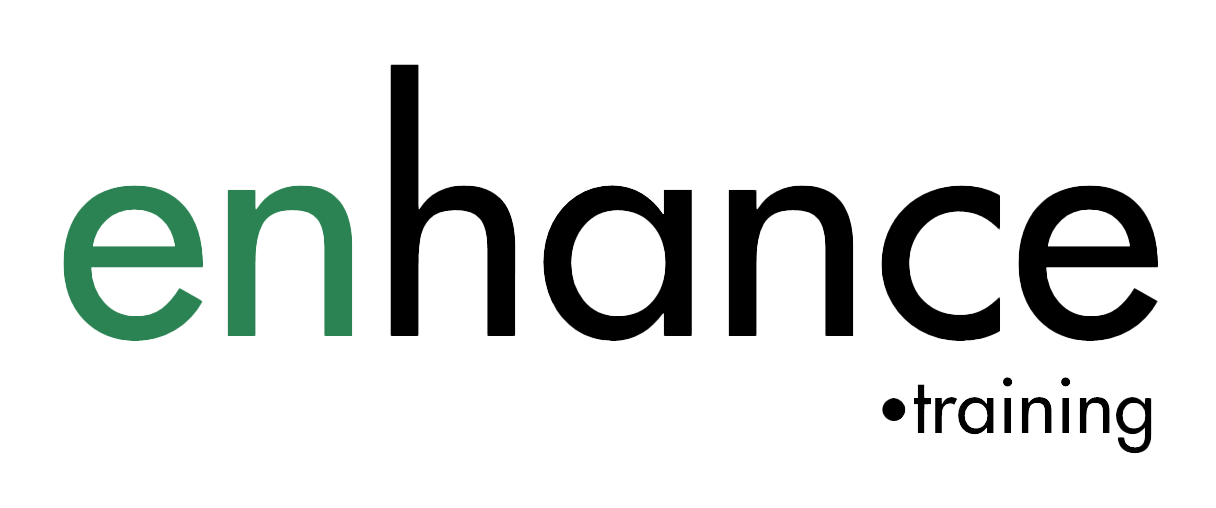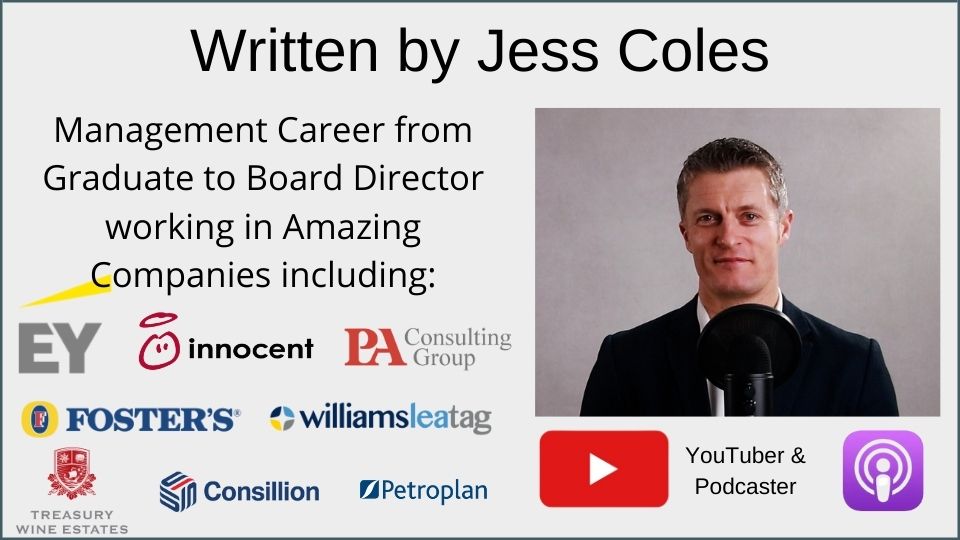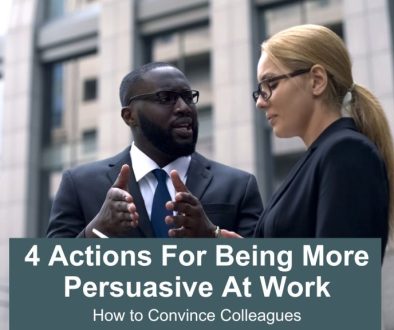How to Give a Great Presentation at Work

How to give a great presentation at work is a key skill to learn for any manager. You will be giving presentations regularly – informally to small groups of your team through to much more formal presentations to larger audiences.
Before we become experienced at presenting to others typical fears include:
- Worrying about what other people think of us
- Fearful of being boring and not keeping the audience’s attention
- Not being sure of how to construct our presentation or what to put on the slides if we are using them
- Worries about how we are going to manage our body-language during the presentation
I will be sharing 9 tips to help you improve your presentation skills, so you can learn how to present like a pro at work
When you are presenting at work, there are 3 main areas to consider:
- The purpose of your presentation and how to construct it
- How to manage your fears and anxieties before and during the presentation
- How to present ourselves while attention is on us
At the end of the article I share 3 tips to help you practice the delivery of your presentation so you present confidently and naturally.
How to give a great presentation at work
- Understand what is important to your audience
- Be Clear on the purpose of your presentation
- Constructing your Presentation
- 3 great ways to start a presentation
- Test the equipment before getting on stage
- The power of smiling and making eye contact
- Managing your voice and body language
- Show you passion and energy
- Finishing your presentation in style
Watch on YouTube
Listen on Podcast
When thinking about how to give a great presentation at work the first thing you should be considering is
Understand what is important to your audience
Start by thinking about your audience and the information you will share with your audience. What are they expecting from you? Familarity – what language and reference points are they comfortable with? What stories might they relate to?
The more in tune with your audience you can make your presentation and the better your presentation meets their needs, the more likely they will take in what you are saying and do what you are asking.
What level of knowledge or understanding does your audience have about the subject you are speaking about? Adjust your presentation to reflect this.
If you were presenting your marketing plan for the year to the leadership team, you would probably focus on how it is going to drive revenue and strengthen the brand and identity of the company.
If you were presenting the same plan to the marketing team, you might touch on these same points and then move on to focus on what tactics, activities and projects will deliver these results. Then you might explain how each team member will contribute.
Tailor your messaging for the audience you are presenting to.
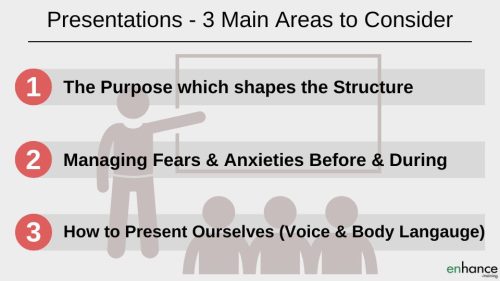
Next my next presentation tip is,
Be Clear on the purpose of your presentation
What are you trying to achieve with your presentation? For instance is your presentation:
- Sharing information and insights
- Asking for a decision
- Sharing a preferred solution for a specific problem
- Selling a product
- Transforming your audience’s perception
- Helping your audience learn
When you are clear about what you are trying to achieve, you are in a much better place to work out how you are going to construct your presentation to achieve your desired goals.
Be clear on the purpose of your presentation.
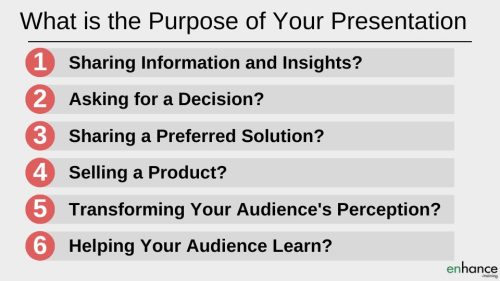
When planning how to give a great presentation at work think carefully about
Constructing your Presentation
Construct your presentation well and your audience won’t get lost, won’t get bored or distracted and will have the best chance of taking in your message or taking the action that you want.
What is your key message? What are the supporting messages? Keep the number of messages you want to get across small, at least less than five. If you have more the audience will forget half of them.
Link sections together logically to tell the story in a way that is easy to follow.
If you are using slides, do not have large amounts of text on each slide. If your audience are trying to read it, they will not be listening to you.
Only have 1-3 bullet points on each slide with a short phrase for each. Even better is to use pictures and diagrams rather than text. What you show on the slides should highlight your key points, nothing more. During the presentation, don’t read out what you have written on your slides. Your audience can and will read.
If you are able to use personal stories to convey your message, this will increase the audience’s retention of what you are telling them.
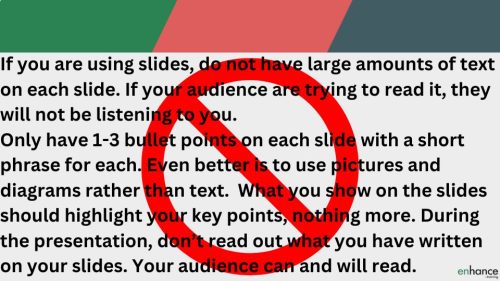
3 great ways to start a presentation
- Tell a story and create curiosity. As a boy I hated being the centre of attention. I would have that sinking feeling in my gut, I would stumble on my words and people would laugh. As I got older, this all improved, yet the fear remained. This all changed about 10 years ago, when I had a conversation with a great presenter. She shared 3 simple secrets with me. They completely changed how I approached presenting…
- Share a fact that shocks. You want to present something to get your audience thinking ideally related to the theme of your presentation. Per a Forbes survey, 70% say presentation skills are critical for career success. The other 30% don’t know it yet.
- Ask a question that matters to the audience. Present a problem for them to start thinking about. If you could remove your fear of presenting, how would that help your promotion prospects?
My fifth of my presentation tips is to
Test the equipment before getting on stage
When doing more formal presentations to larger audiences, or to groups such as to the leadership team, make sure everything is working before your presentation starts.
Don’t spend the first 30 seconds of your presentation finding your slides, checking you are connected to the big screen, your mic is working etc. This is distracting, your audience will switch off or get bored and you set a poor first impression.
Get everything ready and organised before you start so you can start your presentation with impact.
The power of smiling and making eye contact – Presentation Tip 6
Smiling during your presentation transforms your face, your tone of voice and your connection with your audience. Smiling also reduces your nerves and makes you appear a lot more relaxed. So smile during your presentation in a natural way.
I once had a lecturer who used to come in and then literally look at the ceiling throughout the hour of his lecture. We were so distracted checking what was actually on the ceiling and making comments we missed a good bit of what he was saying.
Making eye contact with your audience is very important. Look at individual members of audience as if you are speaking to just them. Don’t stare at one person, or a select few and rotate, or stare generally in the direction of the audience without picking individual people. Try to make eye contact with each member of your audience during your presentation. Make your eye contact brief and friendly. This helps your audience connect with you and stay focused on you and what you are saying.
Manage your voice and body language to give a great presentation at work
We communicate with a lot more than just the words we say. Our tone and pace of voice, how we use our eyes, how we stand and what we do with hands all communicate messages to our audience.
Match your tone of voice to the message you are giving. Communicate your emotions in your voice, your excitement, your thrill of talking to this audience. Change the pace of your voice to communicate your feelings too. Be careful not to speak too quickly or too quietly – make it easy to understand what you are saying.
Stand up straight, tall, and confidently. Keep some attention on yourself and your body language. Don’t allow yourself to get smaller, shake, fidget, pace to much etc.
Use arm gestures that go out and upwards – towards your audience as if you are welcoming them in.
Also pay attention to your breathing. Deep breaths calms you down. Pauses are good particularly after a key point you have just made – it lets the audience take in what you have said before paying attention to the next point you are making.
The eighth presentation tip is to Show your passion and energy
If you show your energy, your interest in your subject and why you feel strongly about it, your audience will be more emotionally involved.
We like listening to people because of the emotion. Great singers include a lot of emotion and feeling in their songs. Great speakers do too.
If you are excited about what you are talking about, you audience will be too. It is hard not to get sucked in to a person that obviously really believes what they saying.
Don’t be afraid to show your emotion and your energy without going overboard.
Finally, lets talk about Finishing your presentation in style
To finish your presentation, think about the key message you want your audience to take away with them and repeat that message.
If you have more than one message, include a quick summary of your key messages or key insights you have shared.
Repeat the call to action if this is appropriate.
You can also end your presentation with a open question to keep them thinking, to create further food for thought so they are more likely to remember your presentation and the key message.
A lastly, don’t forget to thank your audience with a smile.
3 tips to practice your presentation
Practice your presentation from an outline. Do not read a script or try to stick to a script in your head. If you start with a script, keep cutting it down until you have a few bullet points covering each key section of your presentation. Practice your presentation using these bullet points. It will sound more natural and you won’t get stuck trying to remember what word to say.
Secondly, each time you practice, only change one or two points in your presentation. Don’t make lots of improvements in one go. Too many improvements makes it a lot harder to remember what changed which can damage the practice you have already put in.
Thirdly, spread your practice sessions out over time – a least a couple of days. This gives you plenty of time to subconsciously and consciously think about what you are presenting. Better ways to say parts of your presentation will pop into your head.
In summary
So in summary we have gone through 9 tips for how to give a great presentation at work, plus three tips for how best to practice your presentation skills at work.
Being able to present well is a core skill that will impact your ability to progress your career. Reasonable presentation skills are needed to progress through middle management and into senior management.
Make the time to practice how you present at work and you will be a lot more confident plus you will more likely be seen as leadership material by those above you.
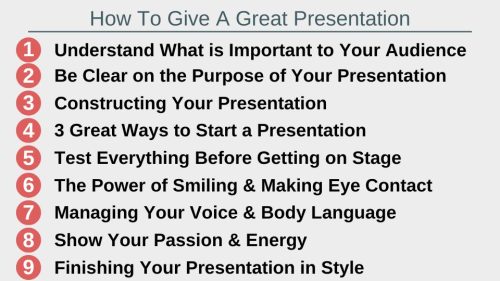
After learning about how to give a great presentation at work,
